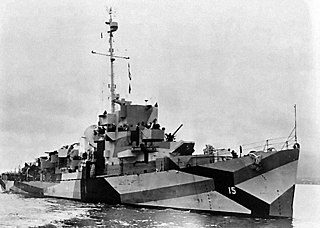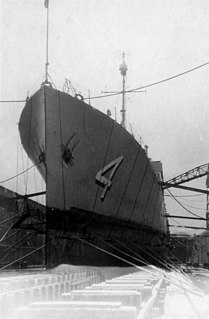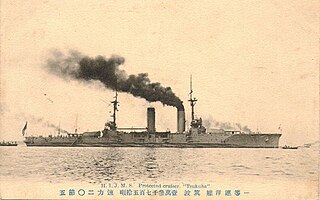Two ships of the Royal Navy have been named HMS King George V, after George V, King of the United Kingdom, whilst another was planned:

USS Austin (DE-15), was an Evarts-class destroyer escort of the United States Navy during World War II. The ship was named for Chief Carpenter John Arnold Austin (1905-1941) who was killed in action on board USS Oklahoma during the attack on Pearl Harbor by Japanese forces on 7 December 1941, and was posthumously awarded the Navy Cross.

Battleship Cove is a nonprofit maritime museum and war memorial in Fall River, Massachusetts, United States. Featuring the world's largest collection of World War II naval vessels, it is home to the highly decorated battleship USS Massachusetts. It is located at the heart of the waterfront at the confluence of the Taunton River and Mount Hope Bay and lies partially beneath the Braga Bridge and adjacent to Fall River Heritage State Park.

USS Sausalito (PF-4), was a Tacoma-class patrol frigate in commission from 1944 to 1945 and from 1950 to 1952, was the only ship of the United States Navy to be named for Sausalito, California. She also served in the Soviet Navy as EK-16 and in the Republic of Korea Navy as ROKS Imchin (PF-66).

Fuji (富士) was the lead ship of the Fuji class of pre-dreadnought battleships built for the Imperial Japanese Navy by the British firm of Thames Iron Works in the late 1890s. The ship participated in the Russo-Japanese War of 1904–1905, including the Battle of Port Arthur on the second day of the war with her sister Yashima. Fuji fought in the Battles of the Yellow Sea and Tsushima and was lightly damaged in the latter action. The ship was reclassified as a coastal defence ship in 1910 and served as a training ship for the rest of her career. She was hulked in 1922 and finally broken up for scrap in 1948.

Yashima was a Fuji-class pre-dreadnought battleship built for the Imperial Japanese Navy (IJN) in the 1890s. As Japan lacked the industrial capacity to construct such vessels, the ship was designed and built in the United Kingdom. She participated in the early stages of the Russo-Japanese War of 1904–1905, including the Battle of Port Arthur on the second day of the war. Yashima was involved in subsequent operations until she struck two mines off Port Arthur in May 1904. The ship did not sink immediately, but capsized while under tow later that day. The Japanese were able to keep her loss a secret from the Russians for over a year. As a result, the Russians were unable to take advantage of the ship's loss.

Hatsuse was a Shikishima-class pre-dreadnought battleship built for the Imperial Japanese Navy (IJN) in the late 1890s. As Japan lacked the industrial capacity to build such warships, the ship was designed and built in the United Kingdom. She participated in the early stages of the Russo-Japanese War of 1904–1905, including the Battle of Port Arthur on the second day of the war, as the flagship of the 1st Division. Hatsuse was involved in the subsequent operations until she struck two mines off Port Arthur in May 1904. The second mine detonated one of her magazines and Hatsuse sank almost immediately afterwards with the loss of over half her crew.

Shikishima was the lead ship of her class of two pre-dreadnought battleships built for the Imperial Japanese Navy by British shipyards in the late 1890s. During the Russo-Japanese War of 1904–1905, the ship fought in the Battles of Port Arthur, the Yellow Sea and Tsushima and was lightly damaged in the latter action, although shells prematurely exploded in her main guns in the latter two engagements. Shikishima remained in home waters during World War I. She was reclassified as a coastal defence ship in 1921 and served as a training ship for the rest of her career. The ship was disarmed and hulked in 1923 and finally broken up for scrap in 1948.

Tsukuba (筑波) was the lead ship of the two-ship Tsukuba class of armoured cruisers in the Imperial Japanese Navy. She was named after Mount Tsukuba located in Ibaraki prefecture north of Tokyo. On 28 August 1912, Tsukuba was re-classified as a battlecruiser.

Ikoma (生駒) was the second vessel in the two-ship Tsukuba class of armoured cruisers in the Imperial Japanese Navy. She was named after Mount Ikoma located on the border of Osaka and Nara prefecture. On 28 August 1912, Ikoma was re-classified as a battlecruiser.

Yamato was the second vessel in the Katsuragi class of three composite hulled, sail-and-steam corvettes of the early Imperial Japanese Navy. It was named for Yamato province, the old name for Nara prefecture and the historic heartland of Japan. The name was used again for the World War II battleship Yamato, commissioned in 1941.

Musashi (武蔵) was the third and final vessel in the Katsuragi class of composite hulled, sail-and-steam corvettes of the early Imperial Japanese Navy. It was named for Musashi province, a former province of Japan located in the Kantō region. The name was used again for the more famous World War II battleship Musashi.

The Fuji class was a two-ship class of pre-dreadnought battleships built for the Imperial Japanese Navy (IJN) in the mid-1890s. They were the first battleships in the IJN, and were constructed in the UK as Japan lacked the industrial facilities needed to build them. Their design was based on the battleships being built for the Royal Navy at that time.

The W1 class minesweeper was a class of minesweepers of the Imperial Japanese Navy (IJN), serving during the 1930s and World War II. 6 vessels were built in 1922–29 under the Eight-eight fleet plan. They have two sub-classes, this article handles them collectively.
Francesco Morosini or simply Morosini has been the name of at least five ships of the Italian Navy, named in honour of Francesco Morosini:
Marcantonio Colonna was the name of at least three ships of the Italian Navy named in honour of Marcantonio Colonna and may refer to:
Three naval vessels of Japan have been named Fusō:
Three naval vessels of Japan have been named Mizuho:

Yashima (PLH-22) is the second ship of Mizuho-class patrol vessel of Japanese Coast Guard.
This page is based on this
Wikipedia article Text is available under the
CC BY-SA 4.0 license; additional terms may apply.
Images, videos and audio are available under their respective licenses.












